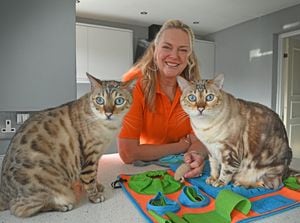Meet the cat behaviourist from Gnosall who is helping to improve the human-feline bond
Helping pet owners to understand their cats a little better while strengthening their human-feline bond is the job of Amanda Champion.

As a clinical animal behaviourist, she looks for clues as to what cats are thinking about the world around them and puts tailor-made plans in place to ensure they feel happier.
Amanda works closely with cats and their owners experiencing issues such as such as toileting in the house, aggressive-type behaviour, anxiety and stress.
“I love engaging with the cat caregivers and deciphering what problems they are having, as well as using my detective skills to find out what the cats’ problems are – so it’s a two-way approach to trying to find a balance where life is harmonious again for cat and for their human guardian,” she tells Weekend.
Her love for all felines – from feral cats to show champions – was inspired by her first cat, Cagney, who Amanda adopted when she was 19.
“Cagney was two and a half when I got him. He was a rescue cat and lived until he was 23.
“He saw me through all my ups and downs and he was there for me. His owners had just moved house and abandoned him and I couldn’t understand how anyone could do that to an animal. I wanted to learn all about him. It was Cagney that inspired by passion for cats and it’s been my passion ever since. I’ve never had less than five cats – the most I’ve ever had was nine or 10,” she explains.

Amanda, who lives in Gnosall, has worked alongside charities for many years helping to rehabilitate cats and previously ran her own cattery, fostering and rehabilitating traumatised shelter cats, enabling them to go in to have happy lives with their new owners.
She particularly had a soft spot for the older cats and the ones experiencing anxiety and other issues that led to them being “overlooked and left behind” by potential adopters.
“You’ve got to work hard to get them to trust you,” she adds.
Amanda is a full member of the Association of Pet Behaviour Counsellors (APBC) and a registered clinical animal behaviourist (CAB) member of the Animal Behaviour & Training Council (ABTC).
All behaviour cases need a vet referral as she says there may be something going on medically which is causing the cat to act the way they are. Once the vet has ruled out underlying health conditions, Amanda will start to look for clues in their body language and in the way they act and interact with their owner. She also looks at their environment – both inside and outside of the home.

All consultations are done remotely via video as Amanda says having a stranger visit the house could be an additional cause of stress for the cat.
“It’s a cat that’s got a problem and that means the cat is not happy in its environment. A lot of cat parents don’t see that and don’t know they might have a cat welfare issue,” she says.
Amanda will also ask to see the views the cat has from the windows and if any new cats have moved into the neighbourhood.
Behaviour such as spraying in the house can be caused by cats feeling threatened or stressed by seeing other cats. Spraying to mark its territory can help the cat feel more secure. A solution can be to use opaque film to obscure the view while still allowing natural light in.
Amanda supported an elderly man who was experiencing difficulties with his beloved Bengal cat who was displaying redirected aggression. “The cat was launching at him and ripping his skin to shreds. That cat was his life and he couldn’t lose him,” she explains.
During the consultation, Amanda realised the Bengal could see other cats in the garden and was becoming frustrated at being unable to reach them. The cat was then taking its anger out on its owner.
As well as obscuring the cat’s window view, Amanda taught the man to recognise the subtle signs of a potential attack so he could interrupt it before it escalated. They also introduced more ways for the cat to play to keep them entertained.
“They started to have a fabulous relationship and even went off in a campervan and had a holiday together,” says Amanda.

She recommends seeking help as soon as possible so that issues can be nipped in the bud before they become embedded behaviour.
Amanda is committed to educating as many people as possible about cat welfare and is often asked to help owners prepare their cats ahead of moving to a new house or the arrival of a new baby. “I think people are starting to value cats as family companions in the same way as they have done with dogs for many years,” she tells Weekend. For Amanda, who is also a feline behaviour counsellor at the Bengal Cat Association, there is always plenty of job satisfaction.
“As a CAB I assist with a wide range of feline behaviours but the most rewarding is to see a previously traumatised or anxious cat start to trust again – this is life-changing for the cat.
“Helping the owners to enrich their cat’s lives and build back bonds that have become broken is so rewarding. It takes effort, it takes time and it’s not a quick fix but with a sustained approach trauma modification therapy can help both cat and owner to find their way to live their best lives together – all nine of them!”
n For more information, see www.kittysitty.net or follow Amanda @kittysittycatbehaviourist on Facebook, Instagram and TikTok for free cat and kitten behaviour help and advice.
